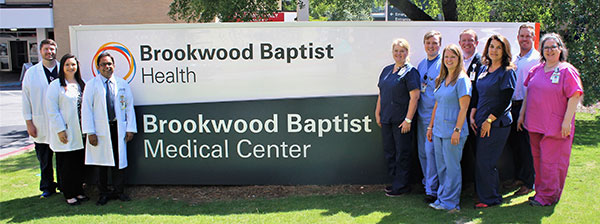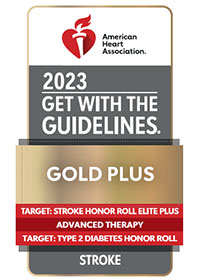What can advanced stroke care mean to your loved one?
Memories. Mobility. Stories. Lives.
When a stroke happens, immediate care is crucial to save a life. And it’s crucial that expert physicians, stroke specialists and neurosurgeons provide that care.
The Primary Stroke Center at Brookwood Baptist Medical Center
Certified Primary Stroke Center
Brookwood Baptist Medical Center is a Certified Primary Stroke Center-designated hospital by the Joint Commission. This means that we are prepared 24 hours a day, seven days a week to treat these most urgent of medical emergencies. Plus, we’re able
to provide the highest level of care to stroke patients, and our team of doctors and staff are trained in advanced stroke care.
Brookwood Baptist Medical Center Stroke Team

Other Awards & Recognition for Stroke Care
 BBMC has received:
BBMC has received:
- Get with the Guidelines – Stroke Gold Plus
- Target: Stroke Honor Roll Elite Plus achievement award, American Heart Association / American Stroke Association for excellence in stroke care
To Save a Brain, remember: BE FAST
With stroke, every second counts. The faster a patient gets to the hospital and receives treatment, the better their chance of recovery. Recognize the symptoms of a stroke so you can react quickly and save a brain – or a life.
Balance. Dizziness or lack of coordination
Eyes. Blurry or double vision or loss of vision in one eye
Face. Ask the person to smile. Does one side of the face droop?
Arm. Is one arm weak or numb? Ask the person
to raise both arms. Does one arm drift downward?
Speech. Is speech slurred or strange? Ask the person to repeat a simple sentence. Do they do it correctly?
Time. Time is critical. If a person shows any of these symptoms, call
911 immediately.
Saving lives. Saving quality of life.
Recognizing symptoms, calling 9-1-1, and receiving emergency care are only the beginning of treatment for a stroke. Brookwood Baptist Medical Center provides ongoing care to help those suffering from stroke regain function for a return to daily living.
- 24/7 neurology coverage
- Access to clot-busting drugs like tPA and other medical procedures
- Interventional neurology
- A dedicated, specialized care team to support patients throughout all aspects of stroke treatment
- Diagnosis and treatment plans based on national guidelines for stroke care
- Physical therapy
- Stroke education for patients and families
Types of Stroke
Ischemic Stroke
An ischemic stroke happens when an artery that supplies blood to the brain becomes blocked. An ischemic stroke can be treated several ways, individually or in combination, including a mechanical thrombectomy or a clot-busting drug called tPA.
Hemorrhagic Stroke
A hemorrhagic stroke happens when a blood vessel ruptures in the brain, putting too much pressure on the brain tissue and starving it of oxygen. A hemorrhagic stroke can be treated using a variety of non-surgical and surgical methods.
Stroke Treatments
A wide range of stroke treatments are available, depending on the type of stroke and the doctor’s judgment based on the individual’s needs.
Ischemic Stroke
- A mechanical thrombectomy, in which a doctor inserts a catheter into a vein in the groin and runs it all the way up to the brain to remove the blockage
- tPA, a clot-busting drug that can save lives and reduce the long-term effects of stroke. The drug needs to be administered within 90 minutes from the beginning of the stroke, so it’s crucial to recognize the symptoms of stroke and react fast.
Hemorrhagic Stroke
Non-surgical methods:
- Controlling blood pressure
- Stopping any medications that could increase bleeding, like warfarin or aspirin
- Performing a blood transfusion with clotting factors to stop ongoing bleeding
Surgical methods:
- Endovascular treatment, in which a long tube is inserted into a blood vessel in an arm or leg and run up to the brain, and a coil or clip is placed to prevent further bleeding
- Aneurysm treatment, which involves removing part of the skull to find the aneurysm (weakened and ruptured section of the blood vessel) and clamp it to stop the bleeding
- Decompressive craniotomy, which is used in life-threatening situations – a physician opens the skull to remove blood and release pressure on the brain
The stroke specialists at BBMC’s Primary Stroke Center have the expertise to quickly make a diagnosis and intervene with the best treatment possible for the patient’s condition.


 BBMC has received:
BBMC has received:
